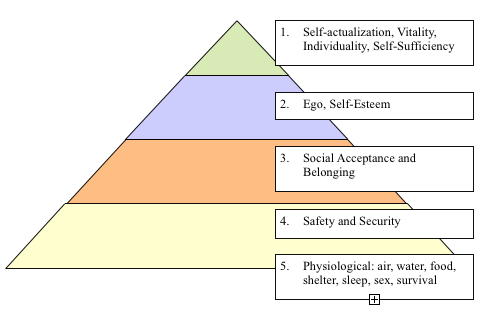Pre-Reading
Take a moment to consider the essay prompt for this test:
Money is the key ingredient to motivating employees.
As you read, take note of any details you think will help you respond to this prompt in your essay.

Exercise
Open the exercise to begin the activity. Preview the questions, then follow the instructions in the document.
After you are finished, complete the Post-Reading Vocabulary Activity. This will help reinforce the vocabulary relevant to this unit.
Reading 2
Motivation Theory and Organizational Behaviour
An old proverb states “You can lead a horse to water, but you can’t make him (or her) drink.” By changing this proverb slightly, we have an accurate view of motivation in the workplace. “You can hire a person to do the job, but you can’t make him (or her) work.”
A key issue in organizational management is motivation of the workforce. This chapter focuses on defining the concept of motivation and examining some theories concerning employee motivation.
What is Motivation?
Motivation can be defined as the processes that account for an individual’s intensity, direction, and persistence of effort toward attaining a goal1. In this definition, the three key elements are intensity, direction, and persistence. Intensity refers to how hard a person tries to accomplish the goal, and in most cases, it is the element most focused on in discussing motivation. In reality, it is not just the fact that a person works hard, but it is also important that the effort is directed, or channelled beneficially towards the goal, and that the effort is persistent, or, in other words, that the person does not easily give up. Motivated individuals are those people who are able to work long enough at a productive activity to achieve a goal.
What is the Role of Managers?
The job of managers in any particular company is to accomplish tasks. In fact the success or failure of a company often rests on the ability of the managers to organize their employees in such a way as to ensure that productivity quotas and deadlines set by company executives are met. But exactly how does a manager ensure that other people accomplish the target tasks by the target deadline? The key to successful management is the ability to motivate employees. This seems simple enough; however, despite enormous research, the subject of motivation is still not clearly understood. In fact, what is becoming clear through this research is that to understand motivation is to gain an understanding of human nature itself. Human nature can be surprisingly simple and surprisingly complex at the same time. What is exciting, rewarding, and motivating to one individual or group may be uninteresting to another individual or group. For managers to provide effective leadership in the workplace, it is essential that this fact be recognized. Managers must recognize that for any program designed to motivate employees in the workplace to be successful, the needs, desires and goals of the particular individuals have to be well understood. Each situation and company is different. What was successful at one time in one company may not work at another time in a different company, or even in the same company.
Theories of Motivation
Research into the complexities of human behaviour has produced a number of theories to account for the variations in human response. The area of motivation is no different. Over the years, many different theories have been developed to explain how humans are motivated to act. Each one of these theories sheds light on a particular aspect of human behaviour. Managers can use an understanding of these theories when attempting to develop methods of motivating their employees to greater productivity in the workplace, but it is also true that they can not rely on one particular theory to effectively explain human behaviour in every situation. In examining these theories, it’s important to remember that there is no right or wrong theory. Parts of each of these theories will be applicable in most situations.
At this point it may be useful to examine one of the most interesting questions concerning human motivation: Are people born with self-motivation and drive? This question prompted the first thinkers on motivation to develop theories, and these theories are still the basis of motivation theory in the modern day workplaces of today.
Theory X emerged from theories of human behaviour developed by Sigmund Freud. This theory sees people as basically lazy; they hate work and avoid it. They have no ambition, take no initiative, and avoid responsibility. All they desire is security. The X theory believes that to motivate people to work they must be rewarded, coerced, intimidated or punished. Managers must always police their workforce because employees cannot be trusted and will never cooperate. In this type of atmosphere, there is little possibility of achievement or creative work.
Theory Y was developed by Douglas McGregor2 who believed that people enjoy learning and that work is a natural activity. The extent to which people pursue work is connected to the extent to which they develop such characteristics as selfdiscipline and self-development. And these traits vary from individual to individual. In this theory, people are motivated, not by money or punishments as in Theory X, but by the freedom to do difficult and challenging work. A manager’s job is to connect the human wish for self-development with the organization’s need for maximum productive efficiency.

Figure 1
Maslow's Hierarchy of Needs
The Hierarchy of Needs Theory was developed by Abraham Maslow3 who made an important contribution to motivational theory when he developed Maslow’s Hierarchy of Needs (See Figure 1). According to Maslow, needs such as the need for food, shelter, or the need for safety and love are like building blocks in the development of the human personality, and the main motivation for human behaviour is to satisfy these needs. When lower level needs are satisfied, people may then move onto the next levels. For example, an employee who begins a new job’s primary concern is relating well to their employer and co-workers. The new employee may be unwilling to assume additional tasks until they feel more comfortable within their work environment. However, until all the needs in a particular level are satisfied, people will not move to the next level. Using this theory to explain human behaviour then, unless the need for food, shelter, safety, and love are met, a person will not be ready for self-actualization.
Maslow’s Theory of the Hierarchy of Needs made a great contribution to the theory of motivation in general because it highlighted the fact that people are constantly driven by internal forces – they are unceasingly motivated toward new goals. However, the feeling of pleasure or satisfaction that accompanies the achievement of a goal is short-lived because as soon as the need is satisfied, it no longer motivates and is then replaced by a new need, a new goal. This everchanging nature of needs is an important aspect of human behaviour and plays an important role in the theory and practice of incentive systems and job development programs.
Fredrick Herzberg provides another, but complimentary approach to motivation and needs fulfilment. 4Herzberg focused his attention specifically on an organization in Pittsburgh, USA where he helped develop a program providing more job satisfaction for its workforce. He found that the factors that make a job satisfying are separate from factors that make it dissatisfying and therefore he classified needs into two categories – dissatisfiers and satisfiers. Thus, improving working conditions can make employees less dissatisfied, but does not necessarily lead to true job satisfaction.
Dissatisfiers relate to what Herzberg referred to as Hygiene Maintenance Factors. Hygiene Factors are conditions conducive to maintaining mental and physical health. These include, for example, salary, status and security, the presence of which reduces job dissatisfaction. Satisfiers, on the other hand, relate to what Herzberg refers to as Motivators and Growth Factors. These factors cause the sense of personal achievement and desire for professional growth. Added responsibility, the work itself, and received recognition contribute to increased job satisfaction. When employees are asked to describe what dissatisfies them in their jobs, they usually complain about the work environment, but when they discuss what satisfies them, they usually talk about the work itself – how interesting it is, their job goals, the recognition and achievement.
Herzberg believes that both Hygiene Maintenance Factors and Motivation and Growth Factors must be satisfied. Employees with jobs they enjoy will usually tolerate poor conditions. However, the less they enjoy the work, the greater the number of Hygiene Maintenance Factors that must be offered in compensation. Workers want to be compensated for the time and effort they give to a job. If they can’t be rewarded through personal satisfaction, then they will seek satisfaction through salary, status, and security.
It is clear the topic of human behaviour and motivation is an extremely complex one. There may be some truth in each of the theories discussed above that will help managers manage better. All situations are unique and the methods managers use in each situation will depend on the particular preferences of the workers and the organizational needs of the institution.
1 See Clark and Avril (2001)
2 See Hans and Anderson (1998)
3 See Principles of Abnormal Psychology (1949)
4 See Higgens (1984)